Humble beginnings
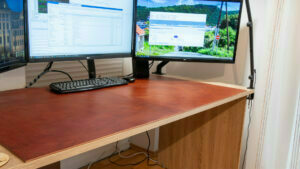
My original home desk was purchased prior to the COVID-19 outbreak and was meant for infrequent and casual use. That means browsing the internet and doing other computer-related activities in the evening and on weekends. COVID-19 changed all that. Now that desk was seeing 8-9 hours of home-office work daily and then a couple of more hours of private use. The desk and chair were purchased from the “Bargain Bin” section of a local furniture store so they were no longer fit for purpose. I want a leather desktop. Not just a leather pad, but the whole surface covered in vegetable tanned leather.
Version 1.0 had two monitors on stands and an A3-sized blue cutting mat as a writing pad. No leather and no style at all. I bought a vegetable tanned leather hide and cut it to size. Then I treated it with neat’s-foot oil, polish and wax to make a nice writing surface for Version 2.0
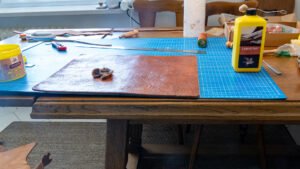
Next came the 2.1 upgrade to a larger and thicker vegetable tanned leather cover. this was purchased directly from a tannery. Then a third monitor was added to the mix. I planned on covering the whole surface of the table, but when buying leather online the dimensions aren’t exact and this one couldn’t be cut to cover the whole tabletop, so I made do by leaving some room on the sides. This was close to the coverage I wanted for a leather desktop, but the foundation was poor.
One evening I noticed that my modifications had resulted in the cheap plywood desktop bowing slightly in the middle and it was time to either put an additional board onto the desk or switch it.
Custom Leather Desktop Part I
I’d always wanted a home workplace with an electrically adjustable height adjustment and after searching Google I discovered that IKEA had a model in stock for a price that was acceptable so I ordered it. 180cm x 80cm tabletop and I found a tannery with a half-hide of raw vegetable-tanned leather which would be big enough to cover the complete desk.
The hides and table components finally arrived and I started construction. I don’t have a bathtub here, but put the hide in the shower and made sure it was soaked through-and-through. I then stretched it in the one position where it was big enough to cover the complete desk (with one small exception, a cut in the hide right at back right-hand side edge). I pulled it into place and around the edges of the tabletop and subsequently used a wooden kitchen roller on the top surface. Rolling from the centre towards the edges made sure that there were no creases. Judicious use of a mallet and smoothing tools on the edges and corners shaped the leather there as well. Finally I used an awl to make holes in the skin edges on the underside for the twine to pull all the sides towards each other. I’m a fan of the trucker’s hitch, which lets you tension lines easily. After things were taut under the table I used some glue on the underside corners and then came the boring part – waiting.
Custom Leather Desktop Part II
It took over 3 days for the leather tabletop to dry sufficiently, despite being in my heated living room. But I guess that 4mm thick vegetable tanned leather can soak up a lot of water and it could only evaporate off the top.
Once it was dry, I removed all my rope-work and trimmed the bottom edges and used contact cement to make sure that everything adhered.
Then came a thorough cleaning using saddle soap, and an overnight drying phase. And finally I could apply the conditioning compound, a beeswax preparation used for waxing saddles. It smells awesome and I used my hands to apply it and have never had softer skin! The heat of my hands melted the wax and let me massage it into the very dry leather. I did this several times, using a cloth and brush between applications to remove any excess. I waited a couple of hours or more between layers so this took some time. The picture show an untreated piece I’d cut from the hide to show how the leather darkened and picked up character and depth during the wax treatment.
I then got the table in place, attached my 3 monitor swivel feet and started cabling up everything so that I could lift the table up high without ripping anything out of the PC.
The work was worth it, not only because I enjoyed working with leather, but because the writing surface is wonderful to work on and resistant to staining from coffee spills and red wine dripping due to the extensive conditioning. I could have used neat’s-foot oil and other items to preserve the leather, but I didn’t want to darken the leather prematurely as I’m sure that the desktop will develop a patina over time.
Addendum in July, 2022
I used one of the scraps of leather from this project to make a work pad that I could put on top of the desk and protect it when doing tasks like soldering or cutting things. I applied 2 layers of light leather oil before waxing it with the same compound as the original tabletop, but the difference in coloration is significant.
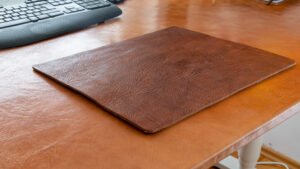
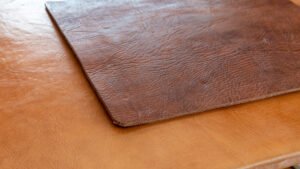

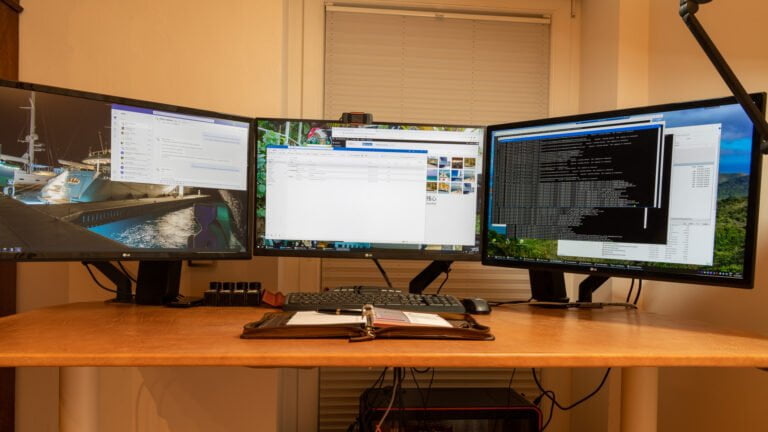

Comments are closed.